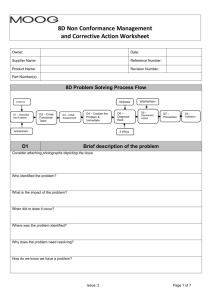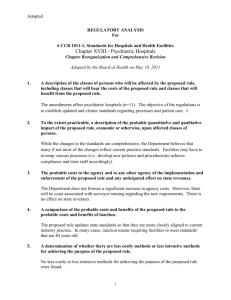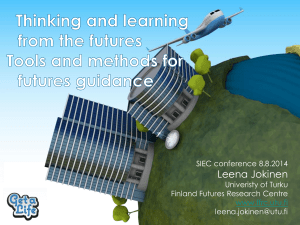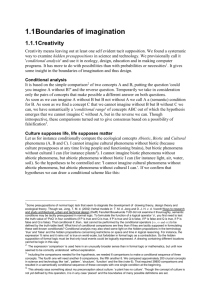Language games in policy, empirical research and design
advertisement
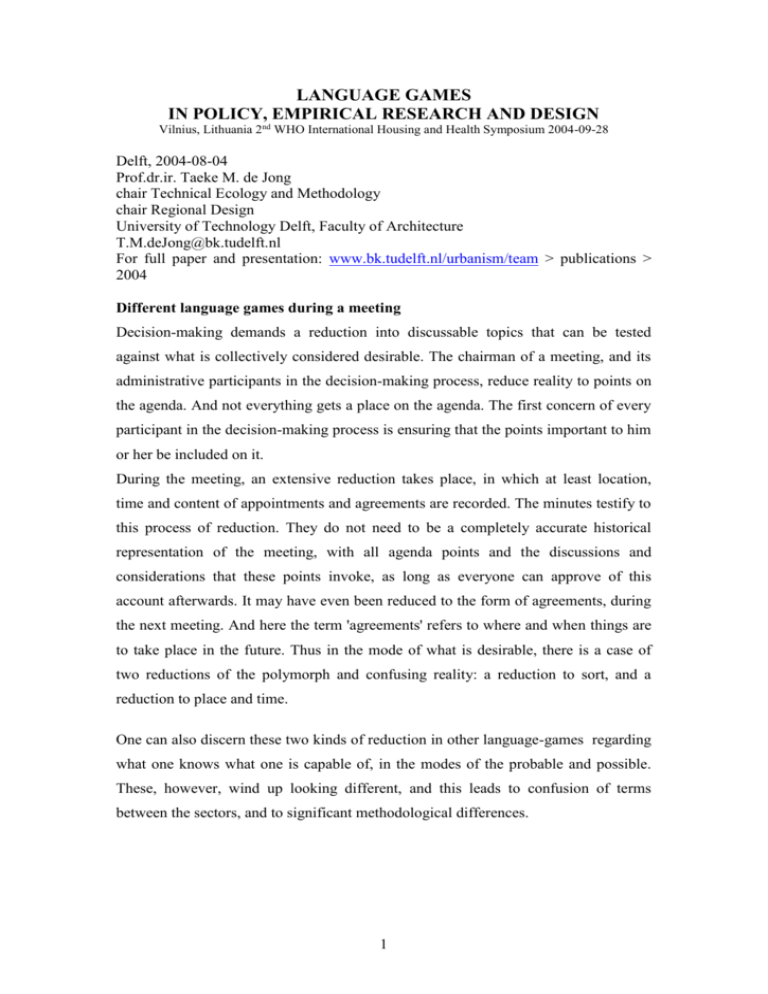
LANGUAGE GAMES
IN POLICY, EMPIRICAL RESEARCH AND DESIGN
Vilnius, Lithuania 2nd WHO International Housing and Health Symposium 2004-09-28
Delft, 2004-08-04
Prof.dr.ir. Taeke M. de Jong
chair Technical Ecology and Methodology
chair Regional Design
University of Technology Delft, Faculty of Architecture
T.M.deJong@bk.tudelft.nl
For full paper and presentation: www.bk.tudelft.nl/urbanism/team > publications >
2004
Different language games during a meeting
Decision-making demands a reduction into discussable topics that can be tested
against what is collectively considered desirable. The chairman of a meeting, and its
administrative participants in the decision-making process, reduce reality to points on
the agenda. And not everything gets a place on the agenda. The first concern of every
participant in the decision-making process is ensuring that the points important to him
or her be included on it.
During the meeting, an extensive reduction takes place, in which at least location,
time and content of appointments and agreements are recorded. The minutes testify to
this process of reduction. They do not need to be a completely accurate historical
representation of the meeting, with all agenda points and the discussions and
considerations that these points invoke, as long as everyone can approve of this
account afterwards. It may have even been reduced to the form of agreements, during
the next meeting. And here the term 'agreements' refers to where and when things are
to take place in the future. Thus in the mode of what is desirable, there is a case of
two reductions of the polymorph and confusing reality: a reduction to sort, and a
reduction to place and time.
One can also discern these two kinds of reduction in other language-games regarding
what one knows what one is capable of, in the modes of the probable and possible.
These, however, wind up looking different, and this leads to confusion of terms
between the sectors, and to significant methodological differences.
1
Choosing
Desirable
Management
LLM.
Policy
Modes:
Sectors:
Education:
Activities:
Reductions Towards
sort: Agenda
place and / or time: Arrangements
Knowing
Probable
Science
Doctor
Empirical Research
Being able to
Possible
Technique
Engineer
Design
Variables
Relationships
Legend
Tolerances
Fig. 1 Language games
The empirical researcher plays an important rôle in the inventory process. (S)he
reduces her or his reality not into points on the agenda, but rather into variables.
These are nameable characteristics, be they verbal, denumerable, numerable, or
measurable , which can take on different or changing values without negating the
designation of the given characteristic. This is a reduction to sort: a dissection
(analysis) of perceptions about actual objects reduced to 'characteristics' that can be
represented and put into operation for studying. This reduction of perceptions allows
for differences or changes (specifically between 'values') in only one direction
('dimension') per variable.
The rest of the perception is excluded as a result of the processes of naming and
delineation (definition), and is often presumed to be the same (ceteris paribus). This
unspoken, undifferentiated quality of 'the rest' is only penetrated when a characteristic
can be designated a variable in the excluded area. As long as this remains impossible,
Wittgenstein's (1919) rule applies: "Wovon mann nicht sprechen kann, darüber muss
mann schweigen".
Any sense of doubt regarding the acceptability of this kind of reduction can be
witnessed, according to the later Wittgenstein(1953), in the post-modern discussion
on the contextuality of 'general' statements (which, if only for that reason, are no
longer 'general') and the differential thinking it has resulted in since Derrida (1972).
The empirical reduction to place and/or time
The reduction to place and/or time is then the (mathematically documented)
simulation of the relationship between variables in order to find a similarity with
reality. The researcher will not rest with the fact that every variable can take on any
arbitrary value: instead (s)he looks for relationships among these variables in order to
further limit their ability to move, with the goal of being able to make predictions,
constructing a 'probable future'.
2
If, after all, possible future characteristics of objects (variables) are supposed to be
able to take on values independent from eachother (as is sometimes required or
caused by design), then there are no longer any expectations one can rely
on.Relationships between variables pre-suppose a far-reaching reduction to place
and/or time, not always acceptible for designers. Indeed, relating two variables
demands a sequential (denumerable) and corresponding arrangement of values in both
variables. Legend units in a drawing do not.
If in the set of perceived values Y from the variable y, for example, any value is twice
as big as that of the same position in x (the first position is 1, the second position is 2,
the third position is 3, etc.) in every counted position in this variable (the first position
is 2, the second position is 4, the third position is 6, etc.), then this is documented in a
mathematical "equation" (y=2x). This relation would become inconceivable if one
were to compare the 1 in X with the 6 in Y, and then the 2 and X with the 2 in Y.
Sequentiality tacitly pre-supposes a fixed sequence in one space or another
(differences) or in time (changes). Without such an internally denumerable spatial or
temporal order, every relationship between variables would become impossible.
There is, however, in this seemingly self-evident form of reasoning, something else
pre-supposed between the lines, something designers are not always able to deal with:
a likeness in distance or duration between the values within one variable (intervals).
The values are not only made denumerable (numerically varying only in their
position) but also countable (computationally the same in the spacing of their subdivisions).
Counting pre-supposes equality in the elements being counted. Thus this is
fundamentally insufficient, if only on the basis of the elements' different spatial and
temporal positions in reality.
If, for example, a programme of requirements for a building is compiled this way, the
designer can find opportunities in the formation of the image to combine or analyse
numbered and computed functions into new functions (categories) that were not
provided for in the variables (and their implicit and largely traditional delimitation)
initially chosen. These must first be designated again in new variables in order to
relate them then to the customer's list of desires, which list has since been changed by
the design. This demands the necessary conceptual abilities from all participants.
3
One can logically conclude that "if x=1, then y=2". Yet this does not establish any
causal relationship: "doubling x causes a doubling of y" (think of the temporal
proportion between the number of storks and births that was once demonstrated in
Sweden) . In empiricism, the step from logical to causal conclusion is often made too
easily, and on closer inspection it has something mystical to it (Hawkins, 1937).
Reductions that go too far for the design
These methods of reducing and representing reality have turned out to be unusually
fruitful in almost every scientific field, except that of formulating the image in design.
The epistemological limits of these 'scientific methods' are greater than many realise,
and are often too big for 'integral' (and differentiating) highly context sensitive
designers. Designers are not called in to recreate what already exists, but rather to
create new possibilities that do not yet exist in a given context. Furthermore, this
method is subject to the law of diminishing marginal returns, now that most of the
globally generalisable relationships between nameable and named variables have been
elucidated. What now remains are more and more context-dependent local problems.
And with this, more (and more varied) causes, or should we more cautiously call
'conditions', are leading to new possibilities within this context. The desired
possibilities here form part of a much bigger collection of possibilities which may be
useful at some point in the lifespan of an architectural object, yet which cannot be
provided for in the programme of present desires. These same causes then lead, even
as a result of minute variations in material and social conditions, to various results
(chaos theory), or the same consequence is elicited by various causes (many roads
lead to Rome). These problems with the empirical method have been studied not only
in architectural and urban design, but in organisation theory and ecology as well .
Design language
Creativity means leaving out at least one self evident tacit supposition. We found a
systematic way to examine hidden presuppositions in science and technology. We
provisionally call it 'conditional analysis' and use it in ecology, design, education and
in making computer programs. It has more to do with possibilities than with
probabilities or necessities . It gives some insight in the boundaries of imagination and
thus design.
4
It is based on the simple comparison of two concepts A and B, putting the question
'could you imagine A without B?' and the reverse question. Temporarily we take in
consideration only the pairs of concepts that make possible a different answer on both
questions.
As soon as we can imagine A without B but B not without A we call A a (semantic)
condition for B. As soon as we find a concept C that we cannot imagine without B but
B without C we can, we have semantically a 'conditional range' of concepts ABC out
of which the hypothesis emerges that we cannot imagine C without A, but in the
reverse we can. Though introspective, these comparisons turned out to give consensus
based on a possibility of falsification. The first consequence of this conditional
analysis is, that C can not be defined without using B and B not without C.
Conditional analysis can clarify a ‘definition space’ of concept C.
Let us for instance analyse conditionally the ecological concepts Abiotic, Biotic and
Cultural phenomena (A, B and C). I cannot imagine cultural phenomena without
biotic ones (because culture presupposes at any time living people and functioning
brains), but biotic phenomena without cultural I can (for instance plants). I cannot
imagine biotic phenomena without abiotic phenomena, but abiotic phenomena
without biotic I can (for instance light, air, water, soil). So the hypotheses to be
controlled are: 'I cannot imagine cultural phenomena without abiotic phenomena, but
abiotic phenomena without cultural I can.'. If we confirm that hypotheses we can draw
a conditional scheme like this:
Jong (1972)
Fig. 2 The ABC model
It seems to be a Venn diagram out of set-theory. But it is not, because set-theory
presupposes more than the concept of presupposition itself. It presupposes for
example the concept of 'element' and any equality of the elements (according to the
criterion of the set). Conditional analysis as applied on 200 concepts in science and
technology by Jong (1992) supposes less.
5
A semantic Venn diagram does not yet need these and perhaps other presuppositions.
The drawn borders are no inward formulated borders of sets and elements, but
outward boundaries of eventually vague and continuous conception. The ABC model
represents phenomena outside culture, but is itself a concept and thus culture.
This raises the philosophical question whether there is any difference between mental
'preconception' (presupposition, assumption) and material 'precondition' (prerequisite)
at all. The environmental crisis taught us however that there appeared preconditions
for life we did not preconceive beforehand. We consider 'environment' in an
ecological sense as the set of conditions for life, known or yet unknown.
Anthropocentric and ecocentric thinking
Let us now try to draw two very different ecological presuppositions that have a direct
influence on the way people design a landscape or townscape: 'Man is part of nature'
and 'Nature is only a human concept'; ecocentrism and anthropocentrism.
Fig. 3 Presuppositions about the relation between culture and nature
Both suppositions contain a paradox. The anthropocentric way of thinking would
imply that physics and biology ('N') cannot find anything new from experiment or
observation that is not already included in the existing set of concepts (C) or its
combinations (idealistic position). Wittgenstein (1919) said: 'The boundaries of our
world are the boundaries of our language.', and: 'About which you cannot speak you
have to be silent.' It was a reason to suspect him of mysticism.
The ecocentric view however would imply that we cannot communicate such
observations. To take these observations serious, we have to regard them as a not yet
cultural part of the natural world N (materialistic position).
Let us now consider culture (C) as an intermediate between the picture ('N') and the
portrayed in the natural world (N). Wittgenstein supposes that the picture and and the
portrayed have their 'logical form' in common.
6
Formal logic however cannot cope with expressions like exclamations, questions,
proposals (like designs) and orders: they have no logical form. That is what occupied
the later Wittgenstein (1953). In my opinion these linguistic expressions are the very
solution to the paradox of ecocentric thinking. Questions are the definition of an
emptiness at the boundaries of knowledge, proposals and designs are excursions in an
unknown, but nevertheless imaginable and perhaps possible future world.
This brings me to a specification of culture, creativity, science and art. Culture is the
set of preconceptions in communication. Suppose we had to explicate all
presuppositions of our communication before we could start with it, in that case we
would seldom have time to communicate. Fortunately we don't have to explicate
every time all these preconceptions, we simply take them for granted and call them
culture. That is easy, but it also keeps 'self-evident' concepts out of discussion.
Creativity just starts with disclaiming these apparently self-evident preconceptions,
science starts with doubting them.
Art is a ripple at the outside boundary of culture denying conventional and adding
unconventional presuppositions by poièsis (making). We need art or technique to
make new concepts outside conventional language.
Science on itself does not provide that.
Probable and possible futures
Probable ecological, economical and cultural futures are gloomy from a viewpoint of
inevitable environmental developments. But are the probable futures the only ones
that we have to take in consideration? Empirical research is limited to the probable
futures. Design, or technical research is limited to the broader set of possible ones.
I cannot imagine the probable without the possible. The reverse I can. What is
probable must be by definition possible.
7
Fig. 4 The modality of the possible
Predicting probable futures requires causal thinking on an empirical basis. We cannot
predict possible futures as far as they are not probable: we have to design them. They
are invisible for probability-calculations. They are fundamentally ab-normal, outside
the 95%-area of probability. Designs cannot be calculated or predicted. If so, they
would no longer be designs. Design produces possibilities, conditions, freedom of
choice, difference.
Designers celebrate exceptions like evolution of life does.
Every line a designer draws is a precondition for further drawing, but not a cause for
the rest of the design process. In the same way the performance of the resulting
building, the behaviour of its inhabitants, is not caused or even necessarily aimed by
the designer, but only made possible in a universum of possibilities opened by the
design. Every line a computerprogrammer writes is a condition for the rest of the
program, but not the cause of its performance. On the other hand one single missing
line can 'ceteris paribus' be called the 'cause' of its break-down. In the same way
global life has no single cause, but many conditions of which lacking one on a single
place and moment can indeed cause the death of an individual. Special conditions of
sunlight, moist and minerals do not cause special life-forms (let alone that they can be
aimed by norms of sunlight, moist and minerals per location), they only make
different life-forms possible. The relation conditional < > causal has its analogies in
the dualities possible < > probable, designing < > predicting, means-directed < > aimdirected, and probably ecocentric < > antropocentric.
8
Fields of problems and objectives for policy, research and design
The field of expected problems often recorded by research is defined by probable
futures we do not want. The field of aims, possible by design is defined by the
desirable futures we do not consider to be probable (see Fig. 5). Policy looks for
windows of opportunity to select solvable problems from that field of problems to be
entered on an agenda that promises success in terms of realisable aims.
Fig. 5 Defining problems and aims
But how to define the fields of probable and desirable futures?
Many companies design extreme scenario's. Often they take two dimensions in
consideration:
national or continental policy running from executing or controlling private
initiatives (!) to own initiative (!) and
national or continental economy running from decline (-) to growth (+),
mostly resulting in 4 scenario's (see fig. Fig. 6). They set ceteris paribus parameters
for empirial research about context and give a frame for decisions. A project proposal
with positive effects in all scenario’s is accepted.
However, national policy could be full of initiative while European policy could
restrict itself to executing or controlling these initiatives. Global economy could be
growing while national economy is declining. So, scenarios have to be made more
explicit in supposed levels of scale. Moreover, economy and policy are not the only
sectors to be taken in account to define probable futures. After all, scenarios can differ
in supposed culture (for instance running from traditional to experimental on different
levels of scale), technology, ecology and distribution of activities in space and time.
To make more explicit scenario's in the field of possible futures I made a computer
programma called FutureImpact (see Fig. 7).
9
Fig. 6 Example of 4 scenario’s based on
Fig. 7 Scenario A from Fig. 6 made scale-
extreme alternatives for government and
explicit by the FutureImpact programme
economy
(Jong, 2004)
A similar second menu of this programme registers the scale of your project and its
possible impacts within the supposed future context. You are asked to locate the
expected and desired impacts of your project.
Fig. 8 The object of your project and its (desired) impacts
A wizard button forces the programme to write a priliminary study proposal. To do
so, the programme subtracts your futures into fields of problems and aims as shown in
Fig. 5. In the produced text you can add considerations you had filling in both menus.
The future context of your project makes possible to evaluate the impact of the
project. The impact after all will change when context changes. Empirical research
mostly does not take other changes of context in consideration (ceteris paribus
10
supposition) than foreseen in a limited number of scenarios. For a design changing
contexts are important, because a building, a neighbourhood, a district, a city always
has to function in changing contexts. This ability to function in different contexts is
called 'robustness'. And context is nothing else then a set of conditions.
Causal discourse as part of conditional reasoning
What kind of thinking do we need for design study to reach robustness of design?
Fig. 9 Causes under conditions
I cannot imagine causes without conditions, the reverse I can. We have to make a step
back from causal thinking about probabilities into the broader area of conditional
thinking about possibilities. Every cause is a condition for anything to happen, but not
every condition is also a cause. The foundation of a house may be a precondition but
not a cause of its existence.
Causal thinking is conditional thinking, but conditional thinking is not always
causal.Suppose we read in the paper: 'The crash of the cars was caused because one of
the drivers lost control of his wheel.' That sounds plausible until an extraterrestrial
descends, saying: 'Nonsense, the collision was caused by two objects approaching
eachother.'
If our hypothetical extraterrestrial is right, the paper is wrong, because if the cars
would not have been approaching eachother and one of the drivers would have lost
control there would have been no collision. So it is only a cause under the tacit
precondition of cars approaching eachother. Every causal conclusion is based on
innumerable tacit conditions called 'ceteris paribus presuppositions'.
11
Fig. 10 Conditional thinking as a ceteris paribus environment of causal thinking
I cannot imagine social possibilities without any economical conditions.
The reverse I can.
I cannot imagine economical possibilities without technical conditions.
The reverse I can.
This gives a semantic conditional sequence of possibilities. However, in stable
technical conditions economical initiatives can cause technical or social change. But
when the dikes burst the technical 'ceteris paribus' conditions for economical
determinism are lacking.
The ceteris-paribus presuppositions (conditions, context) of causal explanations also
change on different levels in time. That means changing causal prediction. They also
can be changed by design forcing shifting explanation about the effects.
Innovative design implies removing some preconditions and making new ones.
Design makes 'ceteris non paribus' conditions. In the same time any design copies
existing conditions. So, more generally speaking design creates conditions, not
causes. After all, designing a house does not mean to cause a houshold, but to make
many households possible. Innovative design implicates always removing
presupposed conditions and making new ones.
Loose from that the set of conditions (context) change in different wave-lengths:
12
Fig. 11 Changing conditions for causal thinking.
Now we can point out a week component in causal thinking. The ceteris-paribus
presuppositions of causal explanations change on different levels and can be changed
by design ... by us.
Professor Helmar Krupp (1996), former director of the Fraunhofer Institut in
Karlsruhe studied physics, pilosophy and sociology. He came to the conclusion that
the individual no longer can influence the evolution of society. Society behaves as a
system with its own dynamics. Individuals have to submit to this dynamics. In the
conference 'The mind of technology', Delft, 27 november 1996, I tried to comfort him
by emphasising design. The limitations of research could be broken by design.
Probable ecological, economical and cultural futures are gloomy from a viewpoint of
inevitable Schumpeter dynamics or Fukuyama-expectations. But are the probable
futures the only ones that we have to take in consideration? Empirical research is
limited to the probable futures, design, innovation or technical research to the possible
ones. And that creates hope.
Conclusion
Policy reduces desirable futures, empirical science probable futures, design science
possible futures.
The intellectual challenge of this century is to handle diversity instead of generalising
it by statistical reduction.
Generalising research has diminishing returns. What could be generalised is mainly
generalised in two centuries of empirical research. Problems left are context sensitive
problems with too little statistical mass for research; they are the non-probable object
of design. However, making your probable future explicit: •protects your project
against judgements with other suppositions about the future•raises the debate about
13
the robustness of your design in different future contexts•raises a 'field of problems'
instead of an isolated 'problem statement' by subtracting the desirable futures from the
probable ones.
References
Ashby, W. R. (1960) Design for a brain the origin of adaptive behaviour (London)
Chapman & Hall.
Bense, M. (1954) Aesthetica (Stuttgart) Deutsche Verlags-Anstalt.
Birkhoff, G. D. (1933) Aesthetic measure (Cambridge, Mass.) Harvard University
Press.
Boersema, C. Peereboom, et al. (1991) Basisboek Milieukunde HOOFDSTUK 01
(Meppel) Boom ISBN 90-6009-977-x.
Claval (1976) De geschiedenis van de aardrijkskunde (Utrecht) Het Spectrum.
Denters, T., R. Ruesink, et al. (1994) Van Muurbloem tot Straatmadelief. Wilde planten
in en rond Amsterdam (Utrecht) KNNV uitgeverij ISBN 90-5011-065-7.
Derrida (1972) Marges de la philosophie (paris) Les Editions de Minuit
Draak, J. den (1993) Van blauwdruk naar draaiboek, scenario's in de ruimtelijke
planning en volkshuisvesting.
Fukuyama, F. (1992) The End of History and the Last Man (New York) Free Press.
Hawkins (1937) Causality and implication (London) Sheed & Ward
Hendriks, L. W. J. L. (1993) Begrippen rond bouwen en milieu (Rotterdam) SBR
Stichting Bouwresearch.
IJsseling, S (1986) Jaques Derrida, een inleiding in zijn denken.
Jong, T. M. d. (1992) Kleine methodologie voor ontwerpend onderzoek (Meppel)
Boom.
Jong, T. M. d. (2002) Verbal models in: T. M. d. Jong and D. J. H. v. d. Voordt Ways
to research and study architectural, urban and technical design (Delft) Faculteit
Bouwkunde TUD
Jong, T. M. d.; J. Louwe (1972) 100 stellingen van Sharawagi 100 stellingen van
Sharawagi (Delft) Faculteit Bouwkunde.
Jong, T. M. de (2004) The future-impact computer programme version 3 (Zoetermeer)
MESO www.bk.tudelft.nl/urbanism/team > Publications 2004
14
Kant, I. (1976) Kritik der reinen Vernunft (Frankfurt am Main) Suhrkamp Verlag.
Koutamanis, A. (2002) Visualization and architecture in: T. M. d. Jong and D. J. M. v.
d. Voordt Ways to study and research urban, architectural and technical design (Delft)
Delft University Press
Krupp, H. (1996) Zukunftsland Japan, Globale Evolution und Eigendynamik
(Darmstadt) Wissenschaftlicht Buchgesellschaft.
Leeuwen, C. G. (1971) Ekologie (Delft) Technische Universiteit Delft, faculteit
Bouwkunde.
Luhmann, N. (1973) Zweckbegriff und Systemrationalität (Ulm) Suhrkamp
Taschenbuch Wissenschaft.
Margulis, L., K. Schwartz, et al. (1994) The illustrated Five Kingdoms; A guide to the
diversity of life on earth (New York) Harper Collins College Publishers ISBN 0-06500843-X.
Margulis, L., K. Schwartz, et al. (1994) The illustrated Five Kingdoms; A guide to the
diversity of life on earth (New York) Harper Collins College Publishers ISBN 0-06500843-X.
Riemsdijk, M.J. van (1999) Dilemma's in de bedrijfskundige wetenschap.
Russell, B. (1919) Introduction to mathematical philosophy (London and New York)
Routledge ISBN 0-415-09604-9.
Stevens, S.S. (1946) On the theory of scales of measurement.
Vos, J. (1993) Natuur in Zoetermeer in: T. M. d. Jong and J. Vos Kwartaalbericht
KNNV Zoetermeer 1-10 (Zoetermeer) KNNV Zoetermeer 2, 1993
Wittgenstein (1919, 1959) Tractatus logico-philosophicus (Oxford) Basil Blackwell.
Wittgenstein, L. (1953) Philosophical investigations (Oxford) Blackwell.
World commission environment and development (1990) Our Common Future
(Oxford/New York) Oxford University press.
15

